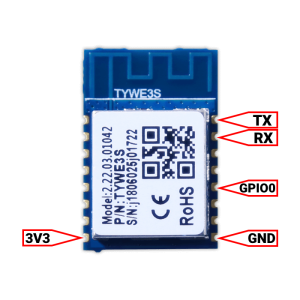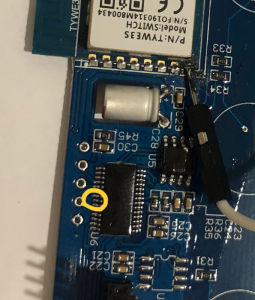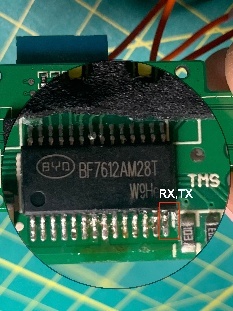Flashing Tasmota
The Treatlife DS01 uses a TYWE3S Chip (ESP8266):
TYWE3S Wiring for Flashing
Vcc - 3.3V
TX - RX
RX - TX
GND - GND
Make sure to ground GPIO0 during boot.
MCU
BYD - BF7612AM28T W9He
TO TRY:
When flashing:
You need to ground RST, GPIO0 to start. after 3 seconds release RST. after another 3 seconds, release gpio0.
Flashing - Preparation
To boot the TYWE3S in flashing mode, GPIO0 needs to be connected to GND while powering up. It can be left grounded for the entire process. Flashing a TYWE3S connected to a MCU is a bit trickier than one without MCU. This is due the same Rx Tx pins used by MCU and serial programmer for flashing. The TYWE3S cannot be booted to flash mode with MCU sending data over the same pins. To be able to do that, we need to disable MCU from sending data over Rx and Tx pins. There are few ways to do it:
1. Disconnect TYWE3S module from the rest of board. (Naah, too much work) 2. Just break the Rx track from MCU to TYWE3S, flash and then reconnect. (Messy work, we want cleaner approach) 3. Just keep MCU disabled while flashing TYWE3S without any soldering / cutting. (We like that)
The easiest is to keep MCU disabled is by identifying the NRST/RST (Reset) pin of the MCU from its datasheet and connect it to GND for the entire flashing process. This will keep MCU disabled while you flash TYWE3S. If there are some contacts or test points in switches that connect to the MCU, you might be lucky to find contacts for RST that you can easily solder onto.
References
| Reference | URL |
|---|---|
| Tasmota - Tuya MCU Devices | https://tasmota.github.io/docs/TuyaMCU-Devices/ |
| Tasmota - TuyaMCU | https://tasmota.github.io/docs/TuyaMCU/ |
| Tasmota - TuyaMCU Protocol | https://tasmota.github.io/docs/TuyaMCU/#tuya-protocols |
| Tasmota Rules | https://tasmota.github.io/docs/Rules/ |
Trying to flash tasmota on TYWE3S #5377 | https://github.com/arendst/Tasmota/issues/5377 |



